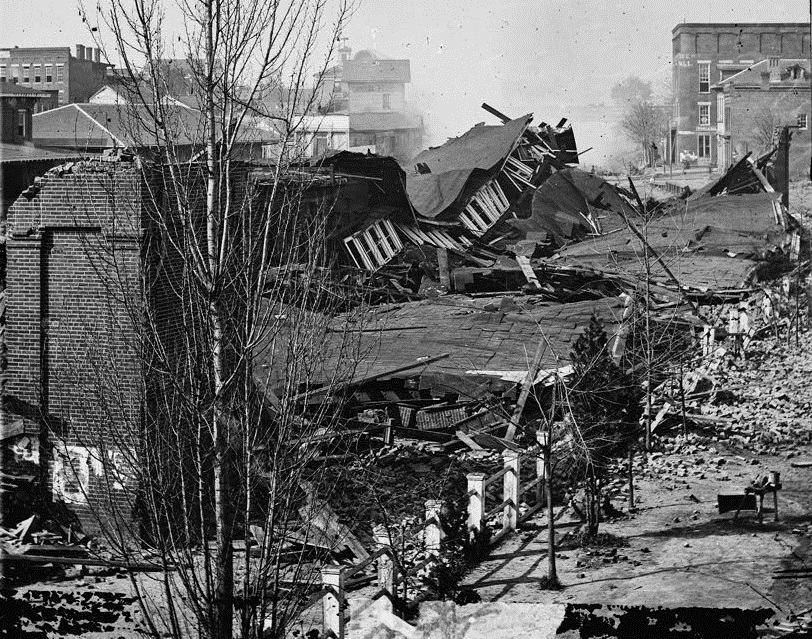Aftermath In Atlanta

Atlanta, Georgia was a key Confederate railway hub throughout the war with a thriving population of about 22,000. Defense of this industrial city fell to Lt. General John Bell Hood and his army, which unfortunately was much too small for the responsibility. News traveled fast as Union General William T. Sherman marched towards Atlanta in autumn 1864. Hood knew he was outnumbered and decided to evacuate the city. His troops escaped safely into the night on September 1st.
The sound of explosions greeted Sherman as he approached Atlanta the same night. Hood and his troops had blown up everything that may have been useful to the invading army. The next day saw Atlanta fall to the Union with an official telegram from Sherman to Washington stating “Atlanta is ours, and fairly won.” Atlanta’s citizens were forced to surrender to the Yankees. Sherman expelled everyone remaining in the city so that he could transform Atlanta into a Union military base.
Sherman and his troops would occupy Atlanta for nearly 45 days. Before they left, they

added to the destruction started by Hood. Judson Kilpatrick a.k.a. Merchant of Terror obliterated all remaining buildings in Atlanta that may have been of use to the Confederacy. The Union troops moved out on November 14th and headed towards Millidgeville, Georgia’s capital. From there they continued on to Savannah before making their way to Columbia in South Carolina. This campaign would later be called the “March to the Sea.”
Atlanta was deserted by both armies and left to smolder, a chilling example of Sherman’s “total war.” The fall of Atlanta boosted the confidence of those north of the Mason-Dixon line and helped Lincoln reign in the support he needed to win the election of 1864. But what of the citizens, those who had evacuated the city during the past two months? Remarkably, many came back soon after Sherman left – despite the pathetic state of the city. Slowly but surely, the returning citizens started

to rebuild and Atlanta rose from its ashes. The city was awarded a phoenix as its official symbol.
As more homes were constructed and the city’s population continued to increase, a writer for the Atlanta Intelligencer described the city as “still viable, but at the time silent, except for the howling dogs.” J.J. Toon, a Confederate publisher working for Atlanta’s government, wrote the following to General W.P. Howard: “…the property of citizens which survived the devouring flame is the exception to the general destruction and demolition intended by our heartless enemies.” Sallie Clayton describes walking past “burnt buildings, piles of rubbish of all sorts, heaps of ashes and clay and odds and ends of almost everything…”
Atlanta’s government had pieced itself back together by early December, despite a startling bank account of only $1.64. Caught in a crossfire of brother against brother, Atlanta was essentially destroyed. However, not all was lost as evinced by those who returned to what was left of their homes. The same individuals who worked hard to build Atlanta in the early 1800s would pick up their tools once again and build an even better Atlanta. Brick and mortar may have been destroyed, but the people had survived.
In the years following the war, Atlanta’s population soon reached a number doubling that of the pre-war city, a trend across much of the south. By 1870 Atlanta boasted a healthy population of nearly 34,000 with over 300 businesses. With a sudden increase in population, however, also came housing shortages and the threat of disease. Without enough doctors or hospitals, two smallpox epidemics claimed the lives of hundreds in the years 1865 ad 186.

At the conclusion of the war, it was clear the life enjoyed in the “old south” no longer existed. Just like the rest of the Confederacy, Atlanta struggled to adjust to the “new south.” With the city’s resources no longer going towards war supplies, Atlanta soon emerged as the industrial and commercial center of the South. By 1868, Georgia decided on Atlanta as its new capital, calling it the “Gateway City to the New South.”